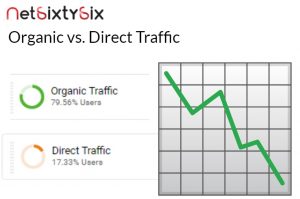When Two Become One: What You Need To Know About Direct Traffic And Organic
When it comes to Search Engine Optimisation (or Search Engine Marketing as it can be called sometimes) it has long been assumed that Organic traffic trumps Direct. This is because higher Organic traffic has been seen as a badge of honour that your dedication to keyword research is actively attracting new customers. But is it right to dismiss Direct traffic? Or, is there a case for including this metric as part of your Organic results? Let’s take a look…
What You Need To Know About Direct Traffic
In Google Analytics, Direct traffic is that which doesn’t have an attributed source. It is generally determined to be users who enter your URL Directly or access your site from a bookmark. Although both are high contributors to Direct traffic, this isn’t the whole picture. There are a few other reasons your Direct traffic might be booming, and these can blur the lines between true Direct traffic and that which is actually an indirect result of your SEO efforts. In other words – Organic. Let’s take a look…

5 Ways Organic Traffic Could Be Mistaken For Direct
- Directing to HTTP from HTTPS
Having an SSL certificate is becoming increasingly important in web development and is also a ranking factor, as confirmed by Google, in 2018 and beyond. But if you haven’t switched to HTTPS yet and your referrals come from a link on a site which has, then the source won’t be trackable.
- Absent Analytics tracking code
If you have added a new page but don’t have your Google Analytics tracking code embedded – or it is broken – then the next page a visitor accesses on your site will be recorded as the first hit. This makes your own site the referrer and chalks one up for Direct traffic.
- ReDirections from inaccurate sources
Meta refreshes – where pages reDirect to another URL after a number of seconds – are notorious for recording traffic as Direct, as are JavaScript-based reDirects.
- Non-trackable documents
If your link is clicked on from a Word, PDF or another non-web document, the referral source will not be recorded.
- Messaging apps and email
Also termed the ‘dark social’, private communication systems such as WhatsApp, Facebook Messenger, SMS and even personal email can’t be tracked. This is also the case with shortened URLs. So if a user clicks on a link sent to them by someone else over these platforms, it will be recorded as Direct. It’s thought as high as 84% of content sharing happens on this hidden side of the net, as opposed to 16% which is shared on public social platforms.
What does this mean for reporting on Direct traffic vs Organic?
 In a nutshell, it can be very difficult to fully separate out your Organic traffic from Direct. This was proven when, in 2014, Groupon took the very brave move of de-indexing their site to determine the extent to which their Organic traffic was getting mixed up with Direct. When they did so, they found that 60% of their Direct traffic was, in fact, Organic, with their Direct traffic falling at the same time as their referrals.
In a nutshell, it can be very difficult to fully separate out your Organic traffic from Direct. This was proven when, in 2014, Groupon took the very brave move of de-indexing their site to determine the extent to which their Organic traffic was getting mixed up with Direct. When they did so, they found that 60% of their Direct traffic was, in fact, Organic, with their Direct traffic falling at the same time as their referrals.
In reality, considering the two – Organic and Direct – as one can prove insightful. In particular, where referrals are coming from the dark social, for instance, it can highlight that you have an active, strong and potentially loyal customer base waiting to be engaged. But how can you prove this if it’s untrackable? You need to tidy up other aspects of your site as much as possible.
This means:
- Get set up with HTTPS
- Don’t just ensure your GA tracking code is in working order on every page; carry out regular audits in Google Analytics to ensure everything is being measured as it should.
- Tag links in email, social and other digital campaigns wherever possible using Google Tag Manager
- Where you must divert to other URLs, then rather than using meta refreshes use server-side 301s which retain 90-99% of rank power.
When you’ve done your best to eliminate these obstacles to accurate reporting, you’ll be left with more representative data on your Direct traffic. Of course, you can still try to drill down into how much of it is Organic by using a number of actions recommended by Moz. As it stands, however, it’s important to realise that the term ‘Direct traffic’ is something of a misnomer as many Organic referrals can be incorporated into this metric. Ignoring Direct traffic risks overlooking a large section of your customer base – and perhaps the most loyal one. Find out more about who your customers are by getting in touch with us at SEO Manchester. Call us on 0845 11 22 530 or email sales@netsixtysix.co.uk.

